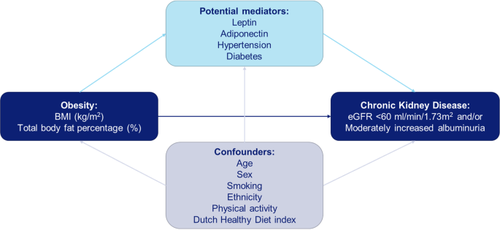Endocrine ( IF 3.7 ) Pub Date : 2024-04-16 , DOI: 10.1007/s12020-024-03811-6 Robin Lengton , Friedo W. Dekker , Elisabeth F. C. van Rossum , Johan W. de Fijter , Frits R. Rosendaal , Ko Willems van Dijk , Ton J. Rabelink , Saskia Le Cessie , Renée de Mutsert , Ellen K. Hoogeveen

|
Purpose
Obesity may promote kidney damage through hemodynamic and hormonal effects. We investigated the association between body mass index (BMI), total body fat (TBF) and chronic kidney disease (CKD) and whether hypertension, diabetes, leptin and adiponectin mediated these associations.
Methods
In this cross-sectional analysis of the Netherlands Epidemiology of Obesity study, 6671 participants (45–65 y) were included. We defined CKD as eGFR <60 ml/min/1.73 m2 and/or moderately increased albuminuria. The percentage of mediation was calculated using general structural equation modeling, adjusted for potential confounding factors age, sex, smoking, ethnicity, physical activity and Dutch healthy diet index.
Results
At baseline mean (SD) age was 56 (6), BMI 26.3 (4.4), 44% men, and 4% had CKD. Higher BMI and TBF were associated with 1.08 (95%CI 1.05; 1.11) and 1.05-fold (95%CI 1.02; 1.08) increased odds of CKD, respectively. As adiponectin was not associated with any of the outcomes, it was not studied further as a mediating factor. The association between BMI and CKD was 8.5% (95%CI 0.5; 16.5) mediated by diabetes and 22.3% (95%CI 7.5; 37.2) by hypertension. In addition, the association between TBF and CKD was 9.6% (95%CI −0.4; 19.6) mediated by diabetes and 22.4% (95%CI 4.2; 40.6) by hypertension. We could not confirm mediation by leptin in the association between BMI and CKD (35.6% [95%CI −18.8; 90.3]), nor between TBF and CKD (59.7% [95%CI −7.1; 126.6]).
Conclusion
Our results suggest that the relations between BMI, TBF and CKD are in part mediated by diabetes and hypertension.
中文翻译:

高血压和糖尿病,但瘦素和脂联素,不介导身体脂肪与慢性肾病之间的关系
目的
肥胖可能通过血流动力学和激素效应促进肾脏损伤。我们研究了体重指数 (BMI)、全身脂肪 (TBF) 和慢性肾病 (CKD) 之间的关联,以及高血压、糖尿病、瘦素和脂联素是否介导这些关联。
方法
在这项荷兰肥胖流行病学研究的横断面分析中,纳入了 6671 名参与者(45-65 岁)。我们将 CKD 定义为 eGFR <60 ml/min/1.73 m 2和/或白蛋白尿中度增加。使用一般结构方程模型计算中介百分比,并根据年龄、性别、吸烟、种族、体力活动和荷兰健康饮食指数等潜在混杂因素进行调整。
结果
基线平均 (SD) 年龄为 56 (6),BMI 26.3 (4.4),44% 为男性,4% 患有 CKD。较高的 BMI 和 TBF 分别与 CKD 发病率增加 1.08 倍(95% CI 1.05;1.11)和 1.05 倍(95% CI 1.02;1.08)相关。由于脂联素与任何结果均无关,因此未将其作为中介因素进行进一步研究。 BMI 与 CKD 之间的相关性为 8.5% (95% CI 0.5; 16.5) 由糖尿病介导,22.3% (95% CI 7.5; 37.2) 由高血压介导。此外,TBF 与 CKD 之间的相关性为 9.6% (95%CI -0.4; 19.6) 由糖尿病介导,22.4% (95%CI 4.2; 40.6) 由高血压介导。我们无法证实瘦素在 BMI 和 CKD 之间的关联(35.6% [95%CI -18.8; 90.3])以及 TBF 和 CKD 之间的关联(59.7% [95%CI -7.1; 126.6])。
结论
我们的结果表明,BMI、TBF 和 CKD 之间的关系部分是由糖尿病和高血压介导的。



























 京公网安备 11010802027423号
京公网安备 11010802027423号